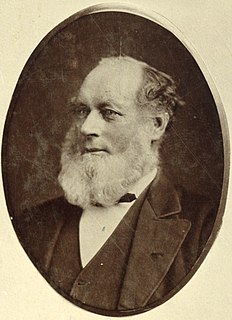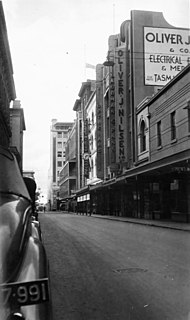
Rundle Mall is a pedestrian street mall located in Adelaide, South Australia. It was opened as a pedestrian mall in September 1976 by closing the section of Rundle Street between King William Street and Pulteney Street, to vehicular traffic. The street continues as Rundle Street to the east and Hindley Street to the west.

Haigh's Chocolates is an Australian family owned bean-to-bar chocolate making company based in Adelaide, South Australia. It was founded in 1915 by Alfred E. Haigh and now has retail outlets in Canberra, Melbourne and Sydney.

Rundle Street, often referred to as "Rundle Street East" as distinct from Rundle Mall, is a street in the East End of the city centre of Adelaide, the capital of South Australia. It runs from Pulteney Street to East Terrace, where it becomes Rundle Road through the East Park Lands.. Its former western extent, which ran to King William Street, was closed in 1972 to form the pedestrian street of Rundle Mall. The street is close to Adelaide Botanic Gardens, Rundle Park / Kadlitpina, Rymill Park, Hindmarsh Square and North Terrace.
This is a timeline of Adelaide history.

John Rundle was a British Whig politician and businessman.

Thomas English was a leading colonial architect in South Australia, Mayor of Adelaide (1862–1863), and a member of the South Australian Legislative Council 1865–1878 and 1882–1884.

Adelaide Arcade is a heritage shopping arcade in the centre of Adelaide, South Australia. It is linked to, and closely associated with, Gay's Arcade.
Charles Moore and Co. was a company based in Adelaide, South Australia which owned a number of department stores in three Australian states. It was founded by Irish-born businessman, Charles Moore. Its best-known assets were the department store known to two generations of Adelaideans as "Moore's on the Square", Charles Moore's on Hay Street, Perth, Western Australia and Read's in Prahran, Victoria.
The Chronicle was a South Australian weekly newspaper, printed from 1858 to 1975, which evolved through a series of titles. It was printed by the publishers of The Advertiser, its content consisting largely of reprints of articles and Births, Marriages and Deaths columns from the parent newspaper. Its target demographic was country areas where mail delivery was infrequent, and businesses which serviced those areas.

Thomas Greaves Waterhouse JP was a prominent businessman, investor and philanthropist in early colonial South Australia arriving soon after the start of official settlement. He was one of the early shareholders of the Burra Burra Mine, and for a long time held a seat on the Directorate. He was also involved in the establishment of the Bank of Adelaide.

George Klewitz Soward was an architect and politician in South Australia.
The Yorick Club was a gentlemen's club in Melbourne, Australia, whose membership consisted originally of men involved in the arts and sciences. It was founded in 1868 and continued in some form into the 1950s and perhaps beyond.
Charles Birks & Co Ltd. was a South Australian department store founded by Charles Napier Birks in Rundle Street, Adelaide. His son Napier Birks took over the business in 1908. The business was acquired by David Jones Limited in 1954.
Alfred Augustus Stump was a photographer and businessman born in Hobart, Tasmania, who had a considerable career in Adelaide.
Birks Chemists is a pharmacy in Adelaide whose origins date back to the 1850s.

Gawler Place is a single-lane road in the city centre of Adelaide, the capital of South Australia. It runs north to south from North Terrace to Wakefield Street, parallel to and approximately midway between King William and Pulteney Streets.
Emanuel Cohen was businessman in South Australia, and was responsible for the erection of several of Adelaide's premier buildings.
Levi Isaacs was a tobacconist and Jewish lay leader in Adelaide, South Australia and Melbourne, Victoria.
Charles Atkins Hornabrook JP was a businessman in colonial South Australia who made a fortune from property development in the city of Adelaide and investments in Broken Hill Proprietary and other mining prospects. He is remembered as the owner and developer of the York Hotel, at the time regarded as Adelaide's finest.
James Marshall & Co. was a department store in Adelaide, South Australia, which was taken over by Myer in 1928.












